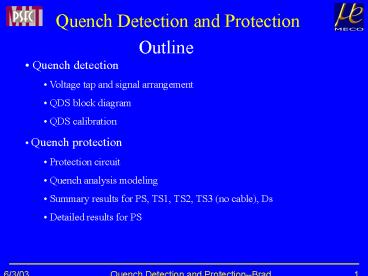Quench Detection and Protection PowerPoint PPT Presentation
1 / 10
Title: Quench Detection and Protection
1
Quench Detection and Protection
Outline
- Quench detection
- Voltage tap and signal arrangement
- QDS block diagram
- QDS calibration
- Quench protection
- Protection circuit
- Quench analysis modeling
- Summary results for PS, TS1, TS2, TS3 (no
cable), Ds - Detailed results for PS
2
Voltage Taps and Connections
- Each coil AND each joint have one pair of
voltage tap wires. - Each voltage tap wire is isolated by a resistor
(not shown)
3
QDS Block Diagram
DC power supply w/ quench protection for DS coil
system
4
QDS Setup
- QDS will be placed on a UPS to ensure protection
is maintained during loss of power. - Digital QDS is backed up by an analog QDS
providing redundancy. - QDS will require calibration at installation
- Only the resistive component of voltage is
desired from each voltage tap pair - Inductive components of voltage are produced at
each voltage tap pair when any one of 6 coil
circuit currents are changing (charge, discharge,
quench). - Current in each power supply is sampled.
- Computer also calculates dI/dt for each circuit
- During installation, each coil voltage tap signal
is trimmed to zero using trial ramps of each coil
circuit at low current.
5
Quench Protection
- The large stored energy of each coil system must
be removed externally while simultaneously
maintaining coil temperatures, stresses and
voltages below acceptable limits.
6
Quench Analysis ResultsAll Coils
7
PS Quench Analysis Results 1
PS Current
Normal zone voltage
PS1 hot spot temperature
Normal zone resistance
Total resistive voltage
8
PS Quench Analysis Results 2
Al shell currents
Al shell temperatures
9
PS Quench Analysis Results 3
- Element temperature data at each time step is fed
into an ANSYS structural model - ANSYS models are run with the Al shells but
without thermal or mechanical preload to
determine desired pre-compression from shell on
coil
- PS1 axial stress after 38 s, showing 45.5 MPa
tension relative to the cold state with no
Lorentz load - Tensile stress must be overcome by Al shell
differential thermal contraction and bolting
preload
PS1 maximum axial compression at 2 s is 10.2 MPa
10
Other Quench Conclusions
- TSu and TSd coils should be fast discharged if
quench is detected in either PS or DS to prevent
over-current. - First DS coil was split in half axially to
eliminate excessive, local r-z plane bending and
attendant shear stress. Results after split
DS1 Shear Stress (0.67 MPa Max)
DS1 Axial Stress (6.5 MPa Max Tension)
DS1 Hot Spot Temperature - End of Quench
Event (Peak Temp 123 K)

